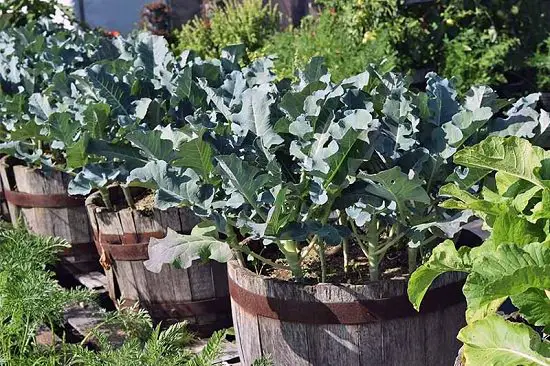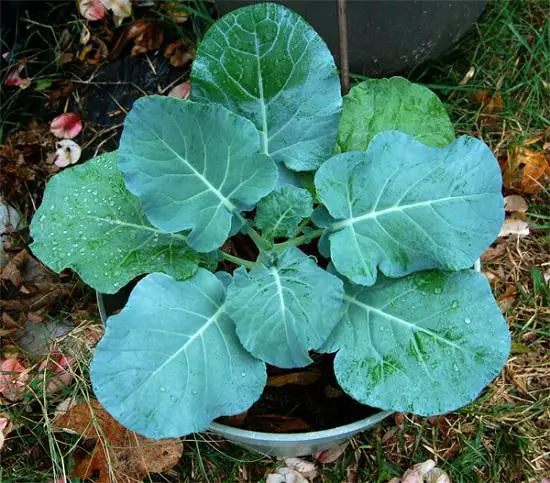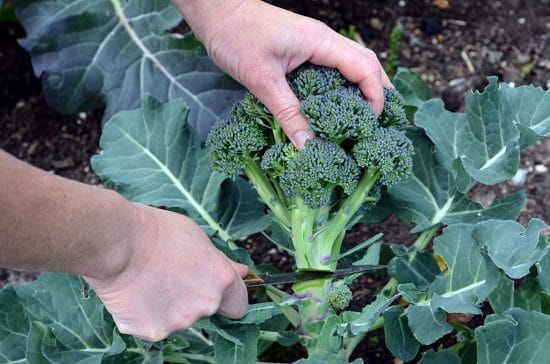Wondering about Growing Broccoli in Pots? This guide will come in handy to make you enjoy this nutritious veggie homegrown!
Broccoli grows best in the cold weather and provides two crops–Spring and fall, in most regions. It can easily be grown in containers. Choosing fast-maturing varieties ensures that you’d be able to enjoy this protein-rich veggie in no time! Let’s know everything about Growing Broccoli in Pots!
Here is everything you need to know about growing cabbages in pots!
What is Broccoli?

Broccoli is a nutritious green vegetable producing large, dark green flowering heads and light green stems. It closely resembles cauliflower, which is also a member of the Brassica family but comes in a different cultivar group.
This green vegetable is loaded with fiber, iron, potassium, vitamin C, and K. It also has more protein compared to other vegetables. Broccoli can be used in a variety of dishes in both cooked and raw form.
Broccoli Varieties
While you can grow any type of broccoli in a pot, there are some varieties that are quick growing and good for containers:
Di Cicco: It is an heirloom cultivar that produces heads instead of stalks. It takes 45-70 days to mature.
Royal Tenderette Hybrid: This is a perfect choice for containers. It forms 3-4 inch stalks and matures in 50-60 days.
Flash: It’s a hybrid variety that gets mature in 50-80 days. Tastes sweet and grows 6-7 inch heads; disease and heat resistant.
Some of the other varieties that you could grow are Happy Rich, Emperor, Marathon, Bonanza, Arcadia, DeCicco, Gypsy, Early Dividend, Paragon, Eureka, Pinnacle Premium, and Citation.
Choosing a Container
For growing broccoli, 8-10 inches pot should be sufficient. For a pot this size, one plant will do the best. It should have adequate drainage holes too. If you are planning to grow multiple plants together, go for a bigger container size with a similar depth recommended above.
How to Grow Broccoli in Pots

Planting Time
As broccoli is a cool-weather crop, it does best in temperature below 75 F (23 C).
For Spring Harvest – Plant seeds 4-6 weeks before the last average frost date in your region. Sow seeds in fall for the best results as the temperature in summer will stunt the growth of broccoli.
For Autumn or Winter Harvest – If you are looking forward to fall or winter harvest, transplant the seedlings in the garden in summer. For regions with mild winter, you can plant it in the fall.
Propagation
From Seeds
- Sow the seeds half an inch deep in individual pots, filled with seed-starting mix.
- Keep the pot in an area where it receives 4-5 hours of sunlight.
- Water regularly to keep the growing medium evenly moist.
- The seeds are going to germinate in 7-14 days.
- When they are 3-7 inches tall with 4 true leaves, transplant them to the desired pots.
From Transplants
- It is easy to grow them this way. Get healthy 3-5 weeks old transplants from a nursery.
- Plant them in individual pots.
- If you are growing multiple plants together, plant them atleast 15-18 inches apart.
Requirements for Growing Broccoli in Pots

Location
For best crop, select a spot that receives a minimum of 5-6 hours of sunlight a day. Avoid growing broccoli in too harsh sunlight or shade. If you own a north-facing balcony, it won’t grow well.
Soil
Broccoli grows well in light, compost-rich, and well-draining soil with a pH of 6.0-6.8. The plant also requires a bit of acidity. You can add lime or leaf mulch into the soil to raise the pH levels.
Tip: Combining equal parts of perlite, vermiculite, and peat moss to make a soil mix for broccoli.
Water
Broccoli prefers evenly moist soil, so maintain it. Make sure the water seeps through the bottom hole and doesn’t accumulate in the pot as overwatering can cause rot.
Broccoli Care
Fertilizer
Side-dress broccoli with aged manure during the time of planting and once again in midseason, when half of its growth is done.
Alternatively, you can also add a slow-release, all-purpose fertilizer during the planting time. The application of liquid fertilizer, every two weeks, will be good enough as well.
Pruning
If the plant is growing vigorously, pruning is the best way to control its growth. Pinch out the newly developing side shoots during the growing season of the plant. You can also cut away wilting leaves from sides. However, refrain from excessive pruning.
Mulching
Mulching broccoli is important as it prefers cool soil. Spreading a 2-inch layer of chopped leaves, hay, or straw over the soil is enough.
Pests and Diseases
Be careful of cutworms, cabbage loopers, and cabbage worms. They can be handpicked or sprayed off with water. In diseases, lookout for clubroot and downy mildew. Pick disease-resistant varieties and provide proper air circulation between plants.
Harvesting and Storage

Broccoli will be ready to harvest in 60-80 days after the transplantation in the desired container/garden. Look out for light green buds and cut them with 4-5 inches of stem. Leave the outer leaves intact as they are going to encourage new growth.
Broccoli tastes best when fresh. You can store them in perforated plastic bags in a refrigerator for 1 week. Do not wash prior to storing.
Broccoli Uses
You can enjoy it lightly sauteed in teriyaki chicken. Also, roast and add them to salads. Steamed broccoli tastes amazing with cheese or chimichurri sauce. For enhanced taste, don’t forget to sprinkle fresh herbs! Stir fry and add chili-lime peanut butter sauce for a lip-smacking taste!
Health Benefits of Broccoli

- Brocolli is packed with Vitamins and Minerals.
- It is rich in glucoraphanin, an antioxidant that aids digestion.
- With Kaempferol, it reduces inflammation in the body.
- It is also high in proteins, which makes it ideal for weight watchers.
- It helps in lowering blood sugar levels with its high fiber content.



I need some information my broccoli seedlings are ready and I have pot width 6.5 inches and length 12 inches can they grow easily in it? 😊